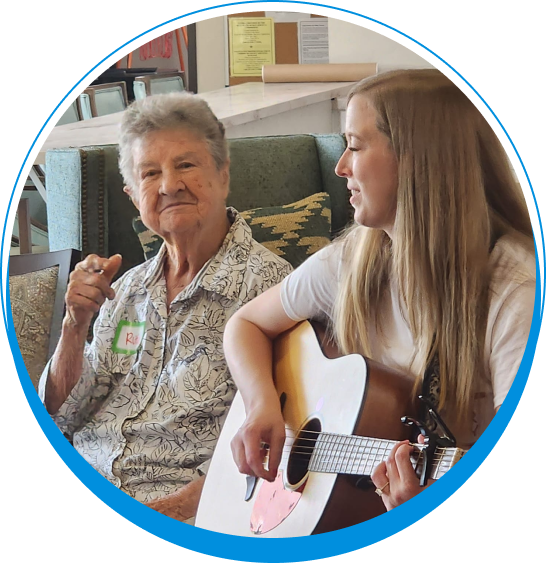When we talk about dementia, we most often talk about Alzheimer’s Disease. After all, it’s estimated that Alzheimer’s accounts for 60% to 80% of all dementia cases. But dementia symptoms are prevalent in other disorders, including frontotemporal dementia (FTD).
FTD is an overarching term that describes a group of disorders characterized by progressive nerve cell loss in the brain’s frontal lobes (the area behind the forehead) and/or the temporal lobes (the areas behind the ears). As the neurons die, the lobes of the brain atrophy (shrink). FTD tends to first manifest through changes in personality, behavior, language, emotions, planning and sequencing, prioritizing, multitasking, and movement first.
According to the National Institutes of Health, FTD is the second most common dementia after Alzheimer’s Disease in people younger than 65. Additionally, FTD:
- Occurs most commonly in people 45-64 years old (60%)
- Is four times more common in men
- Progresses slowly, making it difficult to pick up in the early stages
- Cannot be cured, nor can the progression be slowed
- Generally proves terminal within seven years after the start of symptoms, but is different with each case
FTD Symptoms
In the early stages, people may have just one symptom (corresponding to the first area of the brain affected), but as the disease progresses, other symptoms will appear as more parts of the brain are affected.
Symptoms fall into three key categories:
- Judgment and social behaviors:
- Inappropriate social behaviors (shouting loudly in public, laughing at a funeral)
- Difficulty making decisions (focusing on insignificant details and ignoring important aspects of a situation)
- Problems recognizing emotions in themselves and others and responding appropriately
- Inability to recognize danger (may put their hand in boiling water or reach for a snake, gun, or knife)
- Apathy or exaggerated, incongruous emotions
- Lack of self-awareness and impulse control
- Physical and motor skills:
- Motor difficulties with arms, legs, and mouth; stiffness, balance, neuromuscular weakness
- Abnormal postures of the body
- Gait disorders
- Tremor
- Clumsiness
- Communication:
- Loss of speech and language (an early symptom)
- Trouble linking words to form sentences
- Difficulties finding and understanding words, speaking, reading, writing (cannot write the word “all,” but can write “alligator”)
FTD Causes and Diagnosis
While FTD is not completely understood, its causes are most commonly linked with gene mutations that create protein abnormalities in the brain. While diagnosis is difficult and misdiagnosis often occurs, doctors that are familiar with FTD such as neurologists, psychiatrists, or psychologists can provide expert evaluation through:
- Neurological exams
- Brains scans, such as Magnetic Resonance Imaging (MRI) and glucose positron emission scans are very helpful to look for changes in the frontal and temporal lobes.
- Positron Emission Tomography (PET) scans or Single Photo Emission Computed Tomography (SPECT) may be useful as well since they measure blood flow, glucose usage and oxygen usage in the brain.
- Complete record of person’s symptoms
- Personal and family medical history
- Physical exam and blood tests to rule out other similar conditions
- Genetic testing if appropriate
- Neuropsychological evaluation to assess behavior, language, memory and other cognitive functions
Treatment and Management
The main goal of FTD treatment is to manage symptoms with a robust support team of doctors, nurses, speech therapists, occupational therapists, physical therapists and more. While no medical cure is available, certain medications, such as antidepressants and low-dose antipsychotics, are available for symptom management and to help with quality of life.
As a caregiver for someone with FTD, you can help manage your loved ones’ symptoms through the following tips:
- Do not argue or try to reason with the person. Be as sensitive as you can and try to see the behavior as your loved one’s attempt to communicate.
- To address difficulties with decisions and apathy, offer specific, limited choices.
- Maintain a regular schedule, reduce distractions, and modify the environment to reduce confusion and improve the person’s sleep.
- If compulsive eating is an issue, consider supervising eating, limiting food choices, locking the refrigerator and cabinets, and distracting the person with other activities.
- Encourage moderate exercise to help manage symptoms involving movement.
- Use a communication notebook (an album of photos labeled with names of people and objects), gestures and drawings to communicate without talking.
- Store lists of words or phrases in a computer or phone to point to.
- Speak slowly and clearly, use simple sentences, wait for responses and ask for clarification if needed.
These disorders are not easy to live with, for the person with the illness or their caregivers. But with help, you can meet the challenges. When you feel overwhelmed, take a “timeout” — breathe deeply, count to 10 or leave the room for a few minutes. It’s also crucial to get an early diagnosis and put a support team in place. People who have been diagnosed with a Frontotemporal Disorder can qualify for Social Security disability, which can provide financial protection, and support groups can help both those living with FTD and those who care for them.
Resources:
- The Association for Frontotemporal Degeneration (AFTD)
- The National Institute on Aging – What Are Frontotemporal Disorders? Causes, Symptoms, and Treatment
Learn more about dementia and caregiving by visiting our blog or calling our dementia care specialists at 817-877-1199.


